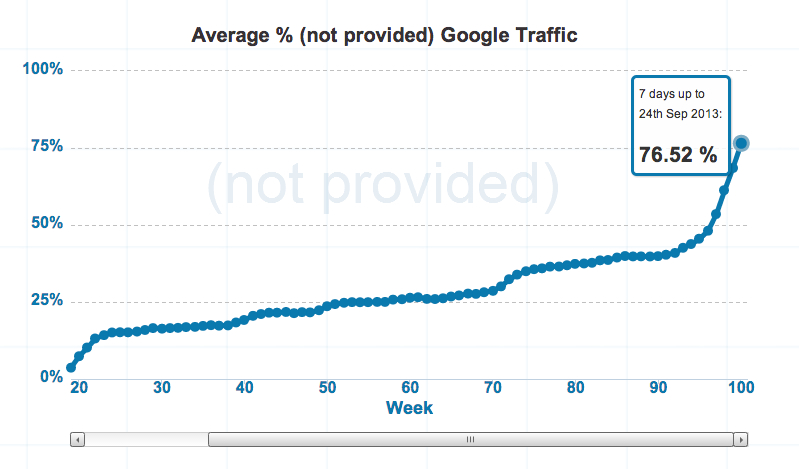It’s good to be the king.
At least, that’s what Google is saying right now. In a unilateral, unannounced, but quantifiable move, Google has made another huge change to a part of its service. This time, they have vastly increased the number of unbranded organic searches that appear as “(not provided)” in Google Analytics reports for webmasters and domain owners.
First of all, let’s review the different types of web traffic sources:
Search traffic
- — Unbranded organic searches are searches which use keywords not associated with a website’s brand. For example, if you own NYTimes.com (if so, lucky you—that domain is valued in the tens of millions of dollars) and someone finds you through the search “best newspaper in America,” that would be unbranded organic search traffic. The search was made by a real person, it did not include the phrase “New York Times,” and the link was not an ad.
- — A paid search is when a user reaches your site through a paid ad (for example, a pay-per-click ad). So if you paid for an ad for the keyword “best newspaper in America” and received a click for that search, that would count as paid search traffic.
- — Branded searches use your brand name. For example, if someone clicks on nytimes.com as a result of the search “New York Times,” that would count as branded traffic.
Direct traffic
- — Visitors to your website that typed the address into their browser’s address bar (or clicked on a bookmark or a link from an email) count as direct traffic—they knew they wanted to visit your website specifically.
Referral traffic
- — Links from other web pages are known as referrals. If someone reaches a New York Times article from a citation on someone’s blog, for example, that would be an example of referral traffic.
Most webmasters and SEOs are primarily concerned with unbranded organic search traffic when thinking about how to improve search rankings. Why? Well, if people are reaching your website directly or through a branded search, that’s great, but they’ve already found you or they at least know who you are. If someone is coming to your website through a link, it’s great to know how much traffic that link generated, but this kind of volume metric does not gauge intent. And if you’ve paid for ads, you want to see that traffic of course, but you paid to get your name at the top—that doesn’t say anything about the quality of your website or the relevance of its content.
Unbranded organic search terms, then, are the prize. If you know what people are searching for when they find your website (i.e. their intent), you can tweak it accordingly, without having to guess.
But what if you couldn’t see what people searched for when they found your website?
Now we have to find out the hard way.
On Monday, industry news sources began lighting up over data which showed that the number of unbranded organic searches that show up as “(not provided)” to a domain’s owner in Google Analytics had drastically increased over a very short period of time. How drastic? According to Not Provided Count, “(not provided)” keywords have increased by more than half in September alone, from around 50 percent of unbranded organic keywords on September 1 to more than 76 percent today, September 25.

Image credit: Not Provided Count
What’s more, this trend shows no sign of stopping, or even slowing down. By the end of the year, 100 percent of all unbranded organic search terms used through Google could become effectively invisible to anyone outside of Google, including the owner of the website the data concerns.
Hold on, what is “(not provided)”?
You might have noticed this at the top of your unbranded organic search reports, probably making up a large percentage of the total search terms.
Google introduced hiding some organic search terms in late 2011. These searches are done through a secure, or encrypted, connection (when you see “https://” in your address bar instead of “http://”) and were originally only for users who were logged in to a Google/Gmail account. The angle was to protect the privacy of Google’s registered users since the point of a secure connection is to prevent third parties from seeing what’s going on.
Over the past two years, however, the number of searches conducted through an encrypted connection has greatly increased, including searches performed by users who are not logged in. Now we can assume almost all (if not all) searches are conducted through a secure connection. That means all of those unbranded searches will show up as “(not provided).”
Why is Google hiding this information?
That’s anyone’s guess, and far be it from me to speculate on the motives of one of the richest and most powerful corporations on the planet. Some have suggested that this move could be because of the bad press they received over the NSA/PRISM scandal, or that it could be a way to boost ad sales since unbranded data is still available for paid searches, or it could be something else entirely. We simply don’t know, and at the end of the day, it doesn’t really matter.
How is Google hiding this information?
Don’t forget that when you’re using Google, you’re using a proprietary service. It’s only free to use because Google is able to effectively print money by selling ads. So while they don’t own the internet, they do arguably own the information they collect about the searches made through their search engine, even if the particular user behind that search is only using Google to eventually get to your website.
Here’s where Google’s power becomes clearly evident: Google handles more than 5 billion searches per day globally, generating something like $137 million dollars per day in revenue (of which about $29 million is straight profit) based on 2012 figures. Additionally, those 5 billion searches account for around two thirds of all global daily searches. That means if someone somewhere in the world is searching for anything on the internet—be it a product, a service, or an answer to a question—there is a 67 percent chance they are using Google. Now, if a user did in fact use Google to end up on your website without using your brand name, you will not be able to see what they searched for in order to get there. Start multiplying to see what kind of effect this can have on how content strategy and SEO effectiveness is measured.
What can I—or you—do about it?
Directly, nothing. Google is going to do what they’re going to do. They are, after all, only answerable to themselves and their shareholders as long as they don’t break any laws. Even though they have potential access to incredible amounts of information about their users, Google, as I mentioned above, effectively owns the rights to that information since it was collected through use of their service. And since the US government doesn’t seem too concerned with our privacy these days (legally, so far privacy has only ever been recognized as a “penumbral” constitutional right, at best), Google hasn’t technically done anything wrong (they even tell you how collected information is used in their privacy policy). In fact, from a privacy standpoint, Google has done us a favor by hiding individual searches. (If you’ve ever had to search for “what to do after you’ve stupidly spilled hot coffee all over yourself,” you may be relieved to know that some webmaster won’t be able to laugh at the search terms in his Analytics report anymore.)
All of that said, there are some more indirect ways around this. Even though it will require more connecting of dots, we can still use all of the other data Google provides to make decisions, predictions, and strategy.
Webmasters and SEOs can also use Bing. So far, Microsoft has not hidden any search terms on Bing Webmaster Tools, paid or not. Bing—which also powers Yahoo!—handles a little over a quarter of global searches. While that’s a far cry from Google’s undisputed dominance, it’s still significant. Therefore, data from Google can be cross referenced with data from Bing in order to make an educated guess as to which keywords are generating higher percentages of traffic for specific pages.
This is just the latest in a year of big changes in the SEO industry. We will continue to watch, learn, and adapt in order to deliver the best results possible with the tools available to us.


